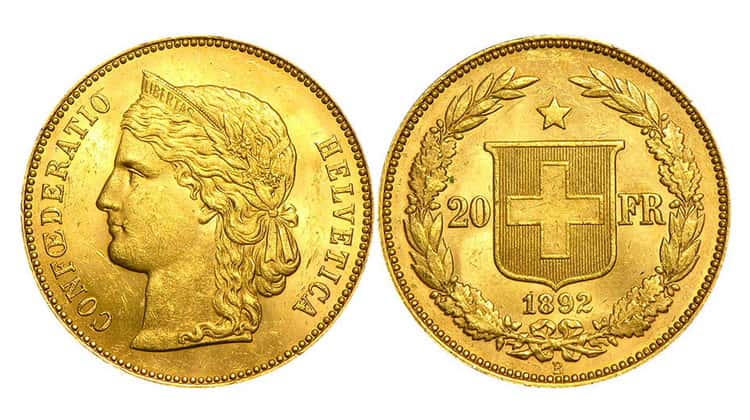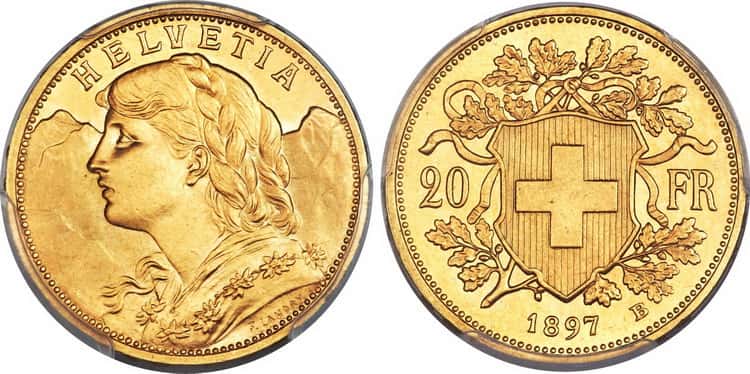
20 Swiss francs (1897-1949) is the most famous series of Switzerland classic gold coins. Gold samples represent the culture and history of the country, as well as the unsurpassed quality of coinage. They are considered the first investment samples that serve as an excellent addition to any numismatic collection. Over the time, the price will increase not only due to the increase in the value of the precious metal, but also the numismatic value. You can find all 20 Swiss Francs gold coins in our catalog.
History
The history of 20 Swiss francs began long before 1897. Between 1883 and 1896, the Swiss Mint produced the first series of gold coins called Helvetia, which is the predecessor of Vrenelli. After joining the Latin Monetary Union (in 1865), Switzerland chose to use a common standard that completely repeated the French “napoleon” (gold 20 francs). Belgium (20 francs), Italy (20 lire), Romania (20 lei), Bulgaria (20 lev) and other countries also used the same weight, size and sample. The net coin weight was 5.80 grams. A total of 1,750,000 coins of Helvetia were minted.
Did you know? The first image of Helvetia appeared in the XVII century, when the famous Johann Caspar Weissenbach in 1672 showed his performance. He personified his homeland for all residents of Switzerland, regardless of nationality or religious affiliation. With his work, he wanted to show that the vast ethnic composition of the country is a single unit. In that historical period, Switzerland consisted of many cantons, and they were inhabited by people speaking different languages (Italian, Roman, French and German). All Switzerland gold coins in our catalog.
But Switzerland did not immediately proceed to the minting of gold coins after it entered the Latin Monetary Union. The country for about 20 years did not produce its own gold coins, and there were two reasons for this:
- The union between Italy, Belgium, France and Switzerland implied the free use of gold coins in other states, which means that the country did not need its own production and for the commodity-currency exchange in its territory managed with the currency of other countries.
- The denominationof 20 francs was set at approximately the market ratio of gold (the standard was 1 to 15), and at this rate it was unprofitable to issue its own gold coins.

The Swiss gold coin Helvetia (20 francs), which was minted from 1883 to 1896, according to the Federal Finance Department of Switzerland, did not sufficiently reflect the culture and history of the country. For this reason, in 1895, the Federal Council decided to transform the existing design. For these purposes, a competition was announced for the best portrait of Helvetia.

In May of 1895, the Commission of the Federal Council of Switzerland, consisting of 21 people, evaluated the options presented for the new 20 francs. The second place was awarded to Fritz Landry (Fritz Ulysse Landry) − a young medalist and sculptor from Switzerland. And although the author’s work was not suitable enough, he was given a second chance − a year later he presented 12 projects for consideration, one of which appealed to the commission members. The Federal Department of Finance invited Mr. Landry to revise his design, with the result that he eventually won first place. All 1848-2009 Swiss Francs gold coins in our catalog.
Did you know? The first prize for the draft of the new 20 francs was not awarded to anyone, since none of those models presented met the expectations of the Federal Department of Finance. For this reason, Fritz Landry won the second place. The members of the commission were looking for an image that could come into contact with all the former allegories of Helvetia and would show the special characteristics of Switzerland.
The name of the new 20 Swiss francs of 1897-1949 was changed from Helvetia to Fresnel. This happened because the word Vrenelli suggested a diminutive version of Verena (this was the name for the new image of a woman on Landry’s specimens). Vrenelli of 1897 became the first investment coin of the country. On its surface was depicted Verena − the allegorical personification of the confederation in the image of a young girl against the backdrop of the Swiss Alps.
In total, three variants of the Vrenelli denominations were minted with the same images:
- 10 Swiss francs (1911-1922)
- 20 Swiss francs (1897-1949)
- 100 Swiss francs (1917-1967)
In the world of investors and collectors, these coins are considered one of the best, because they have a high scratch resistance due to the high content of copper in it. You can find all 10 Swiss Francs and 100 Swiss Francs gold coins in our catalog.
Design
Gold 20 Swiss francs of 1897-1949 have an edge level and a decorative circle from the inside. This is done in order to protect the coin from damage and cut.

Characteristics of 20 Swiss francs 1897-1949
- Material: gold.
- Composition: 900/1000.
- Weight: 6.452 grams.
- Net weight: 5.807 grams.
- Diameter: 21 mm.
- Thickness: 1.25 mm.
- Obverse: On the obverse there is the image of a woman with braided and matched hair. The face is shown in profile. On the neck there is a wreath of edelweiss flowers, and in the background there is an image of the majestic Swiss Alps. The inscription “HELVETIA” is minted along the edge of the construction.
- Did you know? The first trial series of 20 Swiss francs, Vrenelli, minted in the amount of 100 samples, was named Stirnlocke-Vrenelli, because there was a curl on the forehead of a young maiden that fell out of the common strand. According to members of the commission, the nuance did not correspond to the worthy impersonation of Switzerland and looked too frivolous. In 2011, specimens were auctioned off for 100,000 francs.
- Reverse: The main reverse motif is the Swiss national emblem (Celtic cross, surrounded by the rays of the sun). The national emblem is surrounded by oak leaves, which is a symbol of military power. To the left and to the right of the national emblem, the denomination and abbreviation of the currency name “20” and “FR” are minted. The year of release is also marked below, as well as the engraver’s signature “F. Landry” and the mint mark in the shape of the letter“ B ”(city of Bern).
Circulation
20 Swiss francs is considered the most sought-after of the gold series. From 1897 to 1949, the Bern Mint minted over 58,600,000 samples as Uncirculated, and in 1926 and 1935 Brilliant Uncirculated (50,000 and 175,000 coins). From 1897 to 1916, from 200 to 400 thousand coins were produced, and in subsequent years, circulation was increased significantly.
The largest issues of 20 Swiss francs from 1897-1949:
- 1922 – 2,683,678 pcs .
- 1927 – 5,015,000 pcs .
- 1930 – 3,371,764 pcs.
- 1935 – 20,008,813 pcs.
- 1947 – 9,200,000 pcs .
- 1949 – 10,000,000 pcs.
Did you know? Since 1945, the number of Vrenelli has increased significantly. The mass public wondered “where did the rich gold reserves of Switzerland come from?” The allies had their own opinion on this. They assumed that the Swiss banks took possession of the stocks of the German Reich and handed them over to the government. The coins of 1945-1949 minted from this gold did not indicate the current year for a number of reasons. Instead, the year 1935 was indicated as minting to mark the standards of gold samples produced before 1935. In order to distinguish the new coins from the copies of 1935, the production was stamped with L until that year, which meant lingot (ingot).
From 1916 to 1921 and from 1923 to 1924, the Swiss Mint stopped producing coins. The same situation was observed in 1928, 1929, and also from 1930 to 1934, from 1936 to 1947. The gold series of 20 Swiss francs did not come out due to various events, including the Great Depression and the First World War.
Cost of coins
Depending on the year of minting and the degree of safety of the coin, 20 Swiss francs can cost from 265 to 340 $ USD.
Comments
No commens yet.